Soil biological systems drive peak efficiency of both the soil and plant as well as improve productivity. Our focus is on soil microorganisms and biology and not the produce. As organic farmers we realise that 90% of nutrients taken up by our ancient olive trees and ground cover are cycled through soil organisms before they become available to the plant roots. Therefore we are continually working towards creating the optimal soil conditions for maximum water infiltration and nutrient availability.

Microorganisms require nutrients that are provided by the plant. The release of these nutrients is maximised through the process of photosynthesis. With insufficient ground cover throughout the year the microorganisms will experience periods where they will not be able to function at optimal levels. Only by working alongside soil microorganisms will we produce the highest quality extra virgin olive oil.
With a perennial ground cover encompassing a variety of different grasses from shallow to deep rooted, the plants are able to draw nutrients from various levels in the soil. Our specially designed grass mix for our very dry, arid, Mediterranean conditions incorporates 11 different grass varieties. We rely on the deep rooted plants to penetrate the plough pan. A plough pan is the result of ploughing which destroys the top 40cm of soil thus creating ‘a pan’, forming an impenetrable layer. The resulting anaerobic soil environment reduces microorganism activity.


Legumes also play an important role in microorganism health and nutrition as nitrogen fixing plants. The legumes and rhizobacteria have a symbiotic relationship where the bacteria convert nitrogen from the air and make it available for plant use in the form of ammonia. This means that if a plant is able to get sufficient nitrogen for growth (which is also beneficial to the carbon/nitrogen ratio that regulates the release of nutrients), there is no need to rely on chemical fertilisers. We are using mature alfalfa hay at the moment to assist seed germination (broadcasted on a seeded and watered ground surface). Equally this will benefit the microorganisms when it breaks down and releases additional nutrients.
Due to our extreme conditions we are continuing research and experimenting with perennial ground cover mixes (soil armour) to keep our microorganisms functioning at their peak efficiency. Do you think there is a more effective way to improve soil microorganisms? I look forward to your comments.

